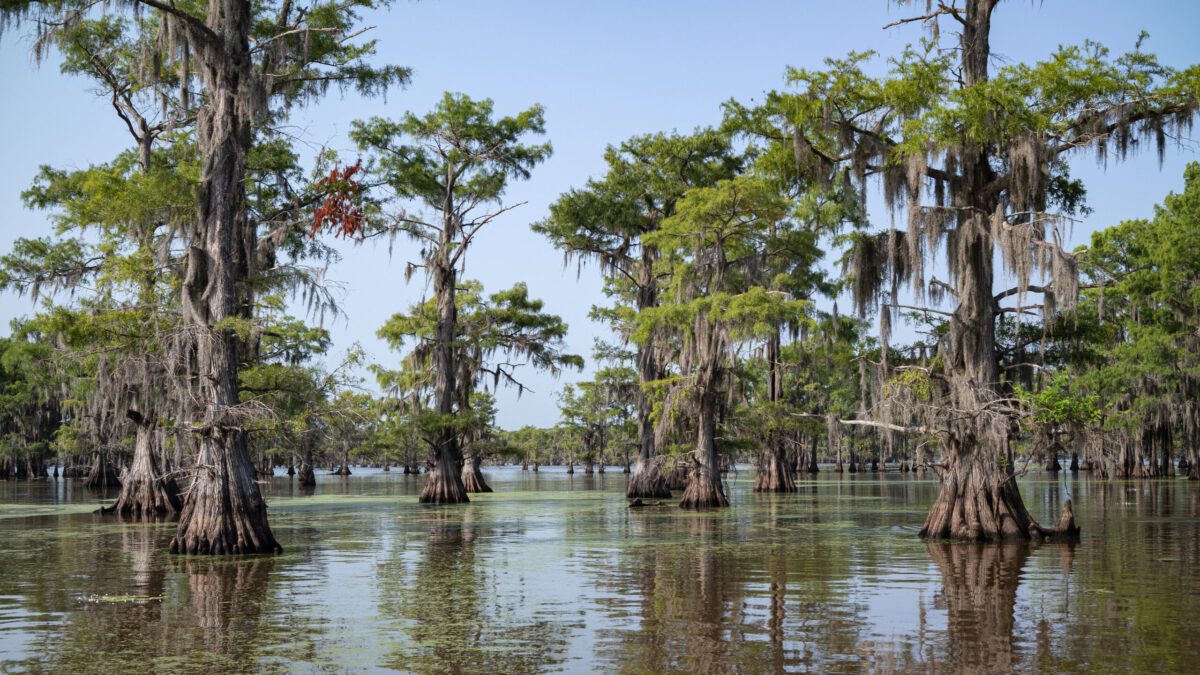
Caddo Lake is one of the many lakes in Texas with refreshing waters and gorgeous views. (Alexander Hatley/CC BY 2.0)
There are thousands of lakes in Texas, but contrary to popular legend around the state, not all of them were created by humans.
Live in Texas long enough, and you might hear about one of the state’s supposed facts: that every lake in Texas is man-made. Some people point to Caddo Lake as the state’s only natural lake. Alas, neither one of those claims is entirely accurate.
Many of the 7,000 or so lakes across Texas are, in fact, created by humans. But there are also plenty that occur naturally. Let’s cannonball into how these lakes came to be.
The manufactured lakes in Texas
Texas sports more than 1.2 million acres of freshwater reservoirs, lakes, and ponds. The man-made lakes in Texas are more accurately called reservoirs, since they’ve been enlarged behind a dam.
Early Spanish settlers built acequias, or irrigation ditches, to ferry water from the San Antonio River to their farms. This impressive 18th century creation served the tribes well, offering fresh water for people to drink and use.
However, as settlers began entering Texas in the 19th century, they encountered a sparse collection of rivers and small creeks. When summer rolled around, the water would sometimes disappear altogether. During heavy rains in the spring and fall, the natural water would often overflow and lead to floods.
Settlers needed a way to avoid droughts and prevent those floods from harming their villages, so they got to work constructing dams. They finished the first dam in 1893 along the Colorado River, and voila! Lake Austin was born. Well, not quite yet—the original was called Lake McDonald and was destroyed in 1900 in a major dam failure. Another dam was built and abandoned (and later destroyed) before the city completed a new dam in 1939, creating the Lake Austin we know today.
This early dam construction proved to be a valuable blueprint for lakes throughout the state. In 1929, Texas launched the Brazos River Authority. While the country was struggling through the Great Depression, the Brazos River Authority welcomed investments to plan 13 new dams along rivers throughout the state. The first of these reservoirs, Possum Kingdom, started construction in 1938.
In the ’50s, a drought devastated Texas; Elmer Kelton documented that period in his book, “The Time It Never Rained.” The event prompted legislators to approve even more artificially constructed lakes across the state. While these lakes are better controlled and offer less risk of natural flooding—though that risk still exists—they impacted ecosystems and eviscerated smaller towns. The creation of the lakes required allowing excess water to flow into areas where it wouldn’t naturally go.
Today, construction of lakes in Texas doesn’t happen very often, though the North Texas Municipal Water District did just finish Bois d’Arc Lake in Fannin County in 2022, with the lake supplying water the following year. We probably won’t see too many more lakes being built, but the state has the power to do so should a situation call for it.
In fact, power is one of the benefits of reservoirs. Yes, the water is refreshing to jump into and helps control flooding and famines. However, the gain of hydroelectric power generation is also significant and can provide energy to cities throughout Texas.
Let’s hear it for natural lakes
If you’re expecting natural lakes of massive proportions across Texas, you might be a bit disappointed. That doesn’t mean there aren’t some great natural options, however.
Caddo Lake is perhaps the most controversial of Texas’s lakes (at least, it’s as dramatic as the history of a lake can be). This body of water on the Texas-Louisiana border was once a “natural” lake after a logjam of trees fell, an event known as the Red River Raft.
Over the years, the federal government began to wade through the raft and move it, which caused Caddo Lake to drain and lose some of its water. The lake was dammed in 1914 and is still a beauty to behold, even over 100 years later. If you visit Natural Dam Lake in Howard County, you’ll encounter another dam-enhanced body of water.
In the Rio Grande Valley, you may encounter “resacas,” smaller natural lakes formed by horseshoe-shaped bends. Typically, these bodies of water become lakes after sediment or other geographical shifts form a break in a river. The result is a horseshoe shape where the water appears to double back on itself.
These horseshoe-shaped bends are also fairly common in East Texas. One of the more famous examples of this type of lake is in Parker County, a part of the DFW metroplex. Aptly named Horsehoe Bend, it’s a census-designated place wth a total area of 1.73 square miles.
At 45,230 acres, Sabine Lake is the largest “lake” in Texas, though it’s technically more of a bay. It’s formed by the Neches and Sabine rivers flowing together and is one of seven major estuaries along the Gulf Coast of Texas. Each of these estuaries consists of a mix of freshwater and saltwater.
Great places to take a dip
Perhaps the moral of the story here is that Texas has plenty of cool bodies of water. Whether you’re jumping into a lake, pool, swimming hole, river, bay, or anything else, you can get your feet (and entire body) wet.
Of course, not all of these swimming spots are created equal. Here are a few of our favorites around the state:
Canyon Lake
Canyon Lake is one of the clearest bodies of water in Texas, offering 80 miles of shoreline for swimmers, fishers, divers, and more. It’s a must-visit while in the Texas Hill Country, and you can make an entire aquatic day of things by pairing a Canyon Lake swim with tubing down the Guadalupe River.
Joe Pool Lake
Joe Pool Lake is one of the artificially constructed lakes in Texas, the result of collaboration between Army engineers, the Trinity River Authority, the Texas Parks and Wildlife Department, and the Joe Pool Lake Planning Council. We’d say those teams did a terrific job, with 60 miles of shoreline and a confluence of water from Walnut and Mountain Creeks.
Tyler State Park Lake
Lakes can be plenty beautiful on their own, but when they’re surrounded by tall trees? That’s just picturesque. Tyler State Park delivers on that front, with a 64-acre lake complemented by foliage everywhere you turn. Hopping in the water is the perfect remedy to soothe aching bones and muscles after a hike, run, or bike ride through the trails.
Lake Whitney
Lake Whitney is Texas’s “Official Getaway Capital,” and with 225 miles of shoreline, you have so much room for splish-splashing around. Just about any water-related activity is fair game here, from swimming and boating to jet skiing and cliff jumping.
The Quince
Camp Wood only has between 500 and 1,000 residents, which means The Quince a hidden gem in Texas. Okay, so it’s more of a swimming hole than a lake, but this is a gorgeous spot of pristine water along the Nueces River. Catch some shade under stunning sycamores and make a splash in the refreshing water.














